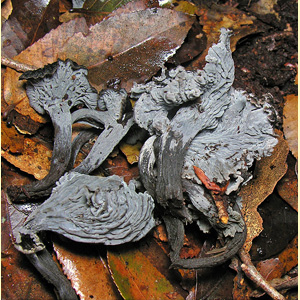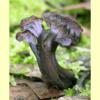
images/Craterellus/Craterellus_PG_GDSCN8890.jpg
medium agaric, growing on the ground or among very rotten wood or at the base of trees, with a white or off-white spore print. Pileus grey or black, rarely brown, not viscid. Lamellae decurrent, rather shallow and often forked or intervenose. Stipe central. Partial veil remnants absent. Spores hyaline, non-amyloid, smooth; germ pore absent. Cheilocystidia absent. Lamellar trama interwoven. Pileipellis a cutis or a trichoderm. Clamp connections present or absent.
Decurrent lamellae that are rather shallow and often contorted are also found in
Cantharellus, but that genus is usually brightly coloured (pink or orange), and clamp connections are always present. Some
Hygrocybe species are dark brown, but the lamellar trama is usually not interwoven (except in subgenus
Cuphophyllus) and the pileus can be viscid or glutinous.
Craterellus Pers., Mycol. Eur. 2: 4 (1825).
One lamellate species:
Craterellus australis (=
Cantharellus cinereus var.
australis).
Craterellus cornucopioides is similarly coloured, but it has deeply infundibuliform fruit-bodies with the hymenium smooth to very shallowly wrinkled, and without lamellae.
N.S.W. and Vic. (and possibly also W.A., N.T., S.A., Qld and Tas.).
In native forests.
On the ground.
Ectomycorrhizal.
Breitenbach, J. & Kränzlin, F. (eds) (1986),
Fungi of Switzerland.
Volume 2. Non gilled fungi. Heterobasidiomycetes, Aphyllophorales, Gasteromycetes. Verlag Mykologia, Lucerne. [
Illustration,
Description and
Microcharacters of
C. cinereus from Switzerland]
Corner, E.J.H. (1966), A monograph of cantharelloid fungi, Ann. Bot. Mem. 2: 1–255. [Description, B&W Illustration, Microcharacters and Key for species of the genus worldwide, some under Cantharellus subgenus Phaeocantharellus]
Dahlman, M., Danell, E. & Spatafora, J.W. (2000), Molecular systematics of Craterellus: cladistic analysis of nuclear LSU rDNA sequence data, Mycol. Res. 104: 388–394.
Grgurinovic, C.A. (1997a), Larger Fungi of South Australia. The Botanic Gardens of Adelaide and State Herbarium and The Flora and Fauna of South Australia Handbooks Committee, Adelaide. [Description and Microcharacters of C. australis]
McCann, I.R. (2003), Australian Fungi Illustrated. Macdown Productions, Vermont. [Illustration of C. australis]
Pegler, D.N., Roberts, P.J. & Spooner, B.M. (1997), British Chantarelles and Tooth-fungi. An Account of the British Cantharelloid and Stipitate Hydnoid Fungi. Royal Botanic Gardens, Kew. [Description, Illustration and Microcharacters of C. cinereus (as Pseudocraterellus) from Europe]





